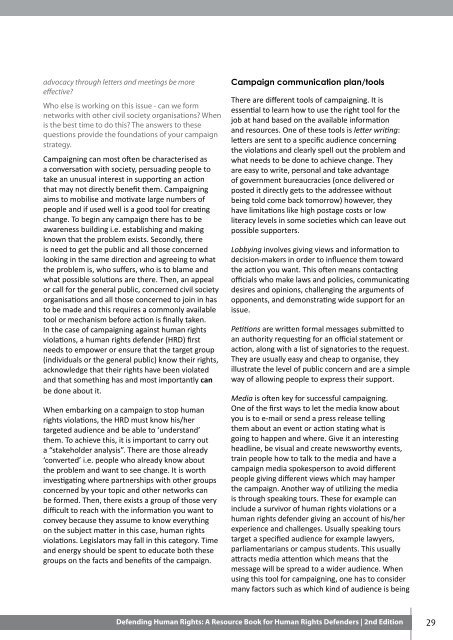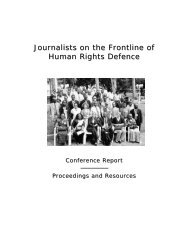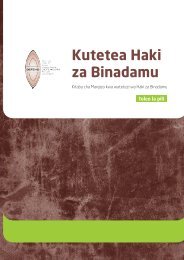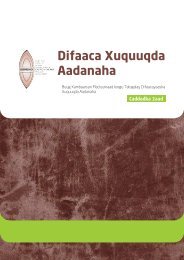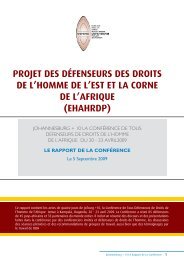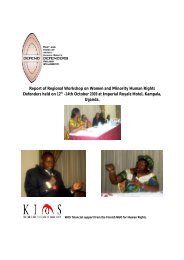Defending Human Rights: A Resource Book for Human
Defending Human Rights: A Resource Book for Human
Defending Human Rights: A Resource Book for Human
You also want an ePaper? Increase the reach of your titles
YUMPU automatically turns print PDFs into web optimized ePapers that Google loves.
advocacy through letters and meetings be more<br />
effective<br />
Who else is working on this issue - can we <strong>for</strong>m<br />
networks with other civil society organisations When<br />
is the best time to do this The answers to these<br />
questions provide the foundations of your campaign<br />
strategy.<br />
Campaigning can most often be characterised as<br />
a conversation with society, persuading people to<br />
take an unusual interest in supporting an action<br />
that may not directly benefit them. Campaigning<br />
aims to mobilise and motivate large numbers of<br />
people and if used well is a good tool <strong>for</strong> creating<br />
change. To begin any campaign there has to be<br />
awareness building i.e. establishing and making<br />
known that the problem exists. Secondly, there<br />
is need to get the public and all those concerned<br />
looking in the same direction and agreeing to what<br />
the problem is, who suffers, who is to blame and<br />
what possible solutions are there. Then, an appeal<br />
or call <strong>for</strong> the general public, concerned civil society<br />
organisations and all those concerned to join in has<br />
to be made and this requires a commonly available<br />
tool or mechanism be<strong>for</strong>e action is finally taken.<br />
In the case of campaigning against human rights<br />
violations, a human rights defender (HRD) first<br />
needs to empower or ensure that the target group<br />
(individuals or the general public) know their rights,<br />
acknowledge that their rights have been violated<br />
and that something has and most importantly can<br />
be done about it.<br />
When embarking on a campaign to stop human<br />
rights violations, the HRD must know his/her<br />
targeted audience and be able to ‘understand’<br />
them. To achieve this, it is important to carry out<br />
a “stakeholder analysis”. There are those already<br />
‘converted’ i.e. people who already know about<br />
the problem and want to see change. It is worth<br />
investigating where partnerships with other groups<br />
concerned by your topic and other networks can<br />
be <strong>for</strong>med. Then, there exists a group of those very<br />
difficult to reach with the in<strong>for</strong>mation you want to<br />
convey because they assume to know everything<br />
on the subject matter in this case, human rights<br />
violations. Legislators may fall in this category. Time<br />
and energy should be spent to educate both these<br />
groups on the facts and benefits of the campaign.<br />
Campaign communication plan/tools<br />
There are different tools of campaigning. It is<br />
essential to learn how to use the right tool <strong>for</strong> the<br />
job at hand based on the available in<strong>for</strong>mation<br />
and resources. One of these tools is letter writing:<br />
letters are sent to a specific audience concerning<br />
the violations and clearly spell out the problem and<br />
what needs to be done to achieve change. They<br />
are easy to write, personal and take advantage<br />
of government bureaucracies (once delivered or<br />
posted it directly gets to the addressee without<br />
being told come back tomorrow) however, they<br />
have limitations like high postage costs or low<br />
literacy levels in some societies which can leave out<br />
possible supporters.<br />
Lobbying involves giving views and in<strong>for</strong>mation to<br />
decision-makers in order to influence them toward<br />
the action you want. This often means contacting<br />
officials who make laws and policies, communicating<br />
desires and opinions, challenging the arguments of<br />
opponents, and demonstrating wide support <strong>for</strong> an<br />
issue.<br />
Petitions are written <strong>for</strong>mal messages submitted to<br />
an authority requesting <strong>for</strong> an official statement or<br />
action, along with a list of signatories to the request.<br />
They are usually easy and cheap to organise, they<br />
illustrate the level of public concern and are a simple<br />
way of allowing people to express their support.<br />
Media is often key <strong>for</strong> successful campaigning.<br />
One of the first ways to let the media know about<br />
you is to e-mail or send a press release telling<br />
them about an event or action stating what is<br />
going to happen and where. Give it an interesting<br />
headline, be visual and create newsworthy events,<br />
train people how to talk to the media and have a<br />
campaign media spokesperson to avoid different<br />
people giving different views which may hamper<br />
the campaign. Another way of utilizing the media<br />
is through speaking tours. These <strong>for</strong> example can<br />
include a survivor of human rights violations or a<br />
human rights defender giving an account of his/her<br />
experience and challenges. Usually speaking tours<br />
target a specified audience <strong>for</strong> example lawyers,<br />
parliamentarians or campus students. This usually<br />
attracts media attention which means that the<br />
message will be spread to a wider audience. When<br />
using this tool <strong>for</strong> campaigning, one has to consider<br />
many factors such as which kind of audience is being<br />
<strong>Defending</strong> <strong>Human</strong> <strong>Rights</strong>: A <strong>Resource</strong> <strong>Book</strong> <strong>for</strong> <strong>Human</strong> <strong>Rights</strong> Defenders | 2nd Edition 29


